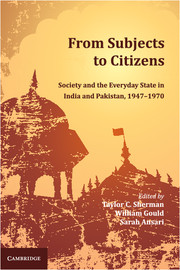Book contents
- Frontmatter
- Contents
- Acknowledgements
- Introduction
- 1 Personal Law and Citizenship in India's Transition to Independence
- 2 From Subjects to Citizens? Rationing, Refugees and the Publicity of Corruption over Independece in UP
- 3 Performing Peace: Gandhi's Assassination as a Critical Moment in the Consolidation of the Nehruvian State
- 4 Migration, Citizenship and Belonging in Hyderabad (Deccan), 1946–1956
- 5 Punjabi Refugees' Rehabilitation and the Indian State: Discourses, Denials and Dissonances
- 6 Sovereignty, Governmentality and Development in Ayub's Pakistan: The Case of Korangi Township
- 7 Everyday Expectations of the State during Pakistan's Early Years: Letters to the Editor, Dawn (Karachi), 1950–1953
- 8 Concrete ‘Progress’: Irrigation, Development and Modernity in Mid-Twentieth Century Sind
- 9 Partition Narratives: Displaced Trauma and Culpability among British Civil Servants in 1940s Punjab
- Contributors
- Index
3 - Performing Peace: Gandhi's Assassination as a Critical Moment in the Consolidation of the Nehruvian State
Published online by Cambridge University Press: 05 February 2014
- Frontmatter
- Contents
- Acknowledgements
- Introduction
- 1 Personal Law and Citizenship in India's Transition to Independence
- 2 From Subjects to Citizens? Rationing, Refugees and the Publicity of Corruption over Independece in UP
- 3 Performing Peace: Gandhi's Assassination as a Critical Moment in the Consolidation of the Nehruvian State
- 4 Migration, Citizenship and Belonging in Hyderabad (Deccan), 1946–1956
- 5 Punjabi Refugees' Rehabilitation and the Indian State: Discourses, Denials and Dissonances
- 6 Sovereignty, Governmentality and Development in Ayub's Pakistan: The Case of Korangi Township
- 7 Everyday Expectations of the State during Pakistan's Early Years: Letters to the Editor, Dawn (Karachi), 1950–1953
- 8 Concrete ‘Progress’: Irrigation, Development and Modernity in Mid-Twentieth Century Sind
- 9 Partition Narratives: Displaced Trauma and Culpability among British Civil Servants in 1940s Punjab
- Contributors
- Index
Summary
Introduction
Despite ever-increasing attention to performance as a mode of politics and the way that performance has shaped political possibilities in the postcolonial era, Gandhi's death and assassination, and associated mourning rituals, have been curiously neglected as sites of historical research. Gandhi was assassinated on 30 January, 1948 and his death was followed by epic public outpourings of grief. A public funeral in New Delhi was followed by a fortnight-long official mourning period and then the immersion of his ashes in Allahabad. By any standards, the public reaction was overwhelming and there was widespread participation in these rituals by a large number of people. The mourners on the river banks at Allahabad were estimated as ‘numbering more than a million’. Indian nationalist historiography placed a considerable amount of emphasis on the date of Gandhi's death as the turning point in ‘communal’ relations after Partition. Such narrative conveyed both the triumph of Congress over the adversities of Partition and the triumph of ‘secularism’ over ‘communalism’. It was also an important way to make sense of Gandhi's assassination, as he was a martyr to the cause of ‘communal’ peace, and the public ‘returned to their senses’ only through his death. Yet the main bulk of posthumous scholarly attention to Gandhi's assassination focuses on the legal case against Gandhi's assassin, the prosecution of the accused and the Congress-directed suppression of the Rashtriya Swayamsevak Sangh (RSS) and other associated religious nationalist movements in the immediate aftermath of the killing.
- Type
- Chapter
- Information
- From Subjects to CitizensSociety and the Everyday State in India and Pakistan, 1947–1970, pp. 64 - 89Publisher: Cambridge University PressPrint publication year: 2014
- 1
- Cited by



